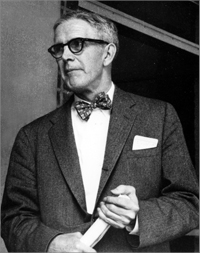Henry DeWolf Smyth (1898-1986) was an American physicist, diplomat, and bureaucrat.
During World War II, Smyth was a member of the National Defense Research Committee’s Uranium Section. He also proposed the electromagnetic methods that were used to enrich the first samples of U-235 during the Manhattan Project. Smyth worked as a consultant for the Manhattan Project from 1943 to 1945 and served as an associate director of the University of Chicago’s Metallurgical Laboratory.
In 1944, Smyth was appointed by General Leslie Groves to the Postwar Policy Committee to propose government policy for research and development of atomic energy after the war. He wrote the official public report on the bomb, Atomic Energy for Military Purposes, which became known as the Smyth Report. The Smyth Report was widely disseminated throughout the country.
After the war, Smyth served as a commissioner on the U.S. Atomic Energy Commission and as U.S. Representative to the International Atomic Energy Agency (IAEA). He was also a professor of physics at Princeton University.
Smyth died on September 11, 1986 at the age of 88.





